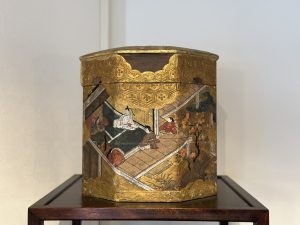和菓子の日(愛知県名古屋市千種区 骨董買取 古美術風光舎)
2023.06.15

皆さま、こんにちは。スタッフMです。
少し気が早いのですが、明日6月16日は「和菓子の日」だそうです。
西暦848年(承和15年・嘉祥元年)の夏、仁明天皇が御神託に基づき、6月16日に16の数にちなんだ菓子、餅などを神前に供えて、疫病を除け健康招福を祈誓し、「嘉祥」と改元したという古例にちなんでいるのだとか。
”嘉祥”とは文字通り「めでたいしるし」であり鎌倉時代には、のちの後嵯峨天皇が東宮となられる前に6月16日に通貨16枚で御供えの菓子などを求めて献じそのことを吉例とし、皇位継承の後もこれが続けられました。
その後、室町時代の「嘉祥の日」には、朝廷で主上に「かづう」(「嘉祥」の祝いのお菓子)を差し上げるのが吉例であったことが「御湯殿上日記」と呼ばれる御湯殿上に奉仕する女官が書き継いだかな文の日記に記載されているそうです。
また慶長の頃、豊臣秀吉が「嘉祥の祝」を恒例として行っていたことも「武徳編年集成・四十四」に記載されていて、江戸幕府においてはこの日大名、旗本など御目見得以上の諸士に大広間で菓子を賜り、このことを「嘉祥頂戴」と呼び、菓子は白木の片木の上に青杉の葉を敷いてそのうえに積んであり、一人一個ずつ取らせたと言われています。
このように、「嘉祥の祝」は、疫を逃れ、健康招福を願うめでだい行事として歴史の中で受け継がれ、明治時代まで盛んに行われていたそうです。そしてこの「嘉祥の日」を現代に復活させたのが「和菓子の日」なのですね。
そして「和菓子の日」にちなんだ写真がこちらです。

先日友人より京都土産でいただきました琥珀糖です。琥珀糖が生まれたのは江戸時代、当時高級品だった砂糖が庶民に普及しはじめ、寒天と砂糖を混ぜるだけのお菓子が作られるようになったことが始まりと言われています。
まだ当時は”琥珀糖”と呼ばれておらず、”金玉糖”と呼ばれていて、”琥珀糖”と呼ばれるようになったのはくちなしの実で着色したことがきっかけでつけられたそうです。
宝石のような見た目の琥珀糖、最近ではSNSでも話題になっているようでして実際に食べてみたところ砂糖のシャリっと感と中はぷるんと柔らかい食感で見た目も味もすべて楽しめるのが魅力でした。
では。
Hello everyone. This is staff M.
I know it’s a little early, but tomorrow, June 16th, is “Wagashi Day”.
In the summer of 848 A.D. (Jowa 15/Kashō 1), Emperor Ninmyo, according to an oracle, offered sweets and rice cakes associated with the number 16 to the altar on June 16th to ward off epidemics and promote good health. It is said to be related to the old example of changing the name to ‘Kaisho’ after praying for good fortune.
“Kaisho” literally means “auspicious sign,” and in the Kamakura period, before the future Emperor Gosaga became the Crown Prince, on June 16th, 16 coins of currency were used to offer sweets and other offerings. As a good example, this continued even after the succession to the throne.
After that, in the Muromachi period, on “Kaisho Day”, it was customary for the Imperial Court to present “Kazuu” (sweets to celebrate “Kaisho”) to the chief, which is called the “Oyudonojo Nikki.” It seems that it is described in the diary of Kanabun, which was handed down by a court lady who serves on the Yudono.
Also, in the Keicho era, Toyotomi Hideyoshi held the “Kaisho celebration” as a custom, which is also described in “Butoku Henen Shusei 44,” and in the Edo shogunate, daimyo and hatamoto were seen on this day. It is said that the confectionery was given to the officials of Toku and above in the large hall, and this was called ‘Kasho-chodai,’ and that the confectionery was piled on top of a piece of white wood with green cedar leaves spread out, and each person was asked to take one. It is
In this way, “Kaisho no Celebration” has been handed down throughout history as an auspicious event to escape epidemics and pray for good health, and it is said that it was actively held until the Meiji period. And this “Kaisho Day” was revived in modern times as “Wagashi Day”.
And here is a photo related to “Wagashi Day”.
This is amber sugar that I received from a friend as a souvenir from Kyoto the other day. It is said that Kohakuto was born in the Edo period, when sugar, which was a luxury item at the time, began to spread among the common people, and sweets were made by simply mixing agar with sugar.
At that time, it wasn’t called “Kohakuto” yet, but it was called “Golden sugar”. is.
Amber sugar, which looks like jewels, has recently become a hot topic on social media. It was a charm.
BYEBYE.
*******************
ご実家の整理やお片付けなどをされている方のご相談などが多くございます。
お片付けなどくれぐれもご無理のないようになさってくださいませ。
風光舎では古美術品や骨董品の他にも絵画や宝石、趣味のお品など様々なジャンルのものを買受しております。
お片付けをされていて、こういうものでもいいのかしらと迷われているものでも、どうぞお気軽にご相談下さいませ。
また風光舎は、出張買取も強化しております。ご近所はもちろん、愛知県内、岐阜県、三重県その他の県へも出張いたします。
まずは、お電話お待ちしております。
愛知県名古屋市千種区姫池通
骨董 買取【古美術 風光舎 名古屋店】
TEL052(734)8444
10:00-17:00 OPEN
#出張買取#骨董#古美術#骨董品#絵画#版画#茶道具#刀剣#彫刻

